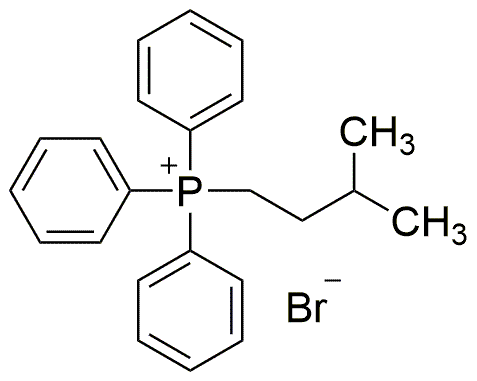Isoamyltriphenylphosphonium bromide is widely utilized in research focused on:
- Organic Synthesis: This compound serves as a powerful reagent in various organic reactions, particularly in the synthesis of phosphonium salts, which are crucial intermediates in the production of pharmaceuticals and agrochemicals.
- Catalysis: It acts as a catalyst in several chemical reactions, enhancing reaction rates and selectivity, which is particularly beneficial in the development of fine chemicals and specialty materials.
- Biological Studies: Researchers use it in cell biology to study membrane dynamics and cellular processes, providing insights into drug delivery systems and cellular interactions.
- Material Science: The compound is employed in the development of advanced materials, such as polymers and nanocomposites, due to its ability to modify properties like conductivity and mechanical strength.
- Analytical Chemistry: It is used as a reagent in analytical methods, aiding in the detection and quantification of various compounds, which is essential for quality control in manufacturing processes.
General Information
Properties
Safety and Regulations
Applications
Isoamyltriphenylphosphonium bromide is widely utilized in research focused on:
- Organic Synthesis: This compound serves as a powerful reagent in various organic reactions, particularly in the synthesis of phosphonium salts, which are crucial intermediates in the production of pharmaceuticals and agrochemicals.
- Catalysis: It acts as a catalyst in several chemical reactions, enhancing reaction rates and selectivity, which is particularly beneficial in the development of fine chemicals and specialty materials.
- Biological Studies: Researchers use it in cell biology to study membrane dynamics and cellular processes, providing insights into drug delivery systems and cellular interactions.
- Material Science: The compound is employed in the development of advanced materials, such as polymers and nanocomposites, due to its ability to modify properties like conductivity and mechanical strength.
- Analytical Chemistry: It is used as a reagent in analytical methods, aiding in the detection and quantification of various compounds, which is essential for quality control in manufacturing processes.
Documents
Safety Data Sheets (SDS)
The SDS provides comprehensive safety information on handling, storage, and disposal of the product.
Product Specification (PS)
The PS provides a comprehensive breakdown of the product’s properties, including chemical composition, physical state, purity, and storage requirements. It also details acceptable quality ranges and the product's intended applications.
Certificates of Analysis (COA)
Search for Certificates of Analysis (COA) by entering the products Lot Number. Lot and Batch Numbers can be found on a product’s label following the words ‘Lot’ or ‘Batch’.
Número de catálogo
Número de lote/lote
Certificates Of Origin (COO)
This COO confirms the country where the product was manufactured, and also details the materials and components used in it and whether it is derived from natural, synthetic, or other specific sources. This certificate may be required for customs, trade, and regulatory compliance.
Número de catálogo
Número de lote/lote
Safety Data Sheets (SDS)
The SDS provides comprehensive safety information on handling, storage, and disposal of the product.
DownloadProduct Specification (PS)
The PS provides a comprehensive breakdown of the product’s properties, including chemical composition, physical state, purity, and storage requirements. It also details acceptable quality ranges and the product's intended applications.
DownloadCertificates of Analysis (COA)
Search for Certificates of Analysis (COA) by entering the products Lot Number. Lot and Batch Numbers can be found on a product’s label following the words ‘Lot’ or ‘Batch’.
Número de catálogo
Número de lote/lote
Certificates Of Origin (COO)
This COO confirms the country where the product was manufactured, and also details the materials and components used in it and whether it is derived from natural, synthetic, or other specific sources. This certificate may be required for customs, trade, and regulatory compliance.


